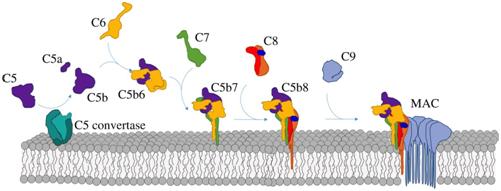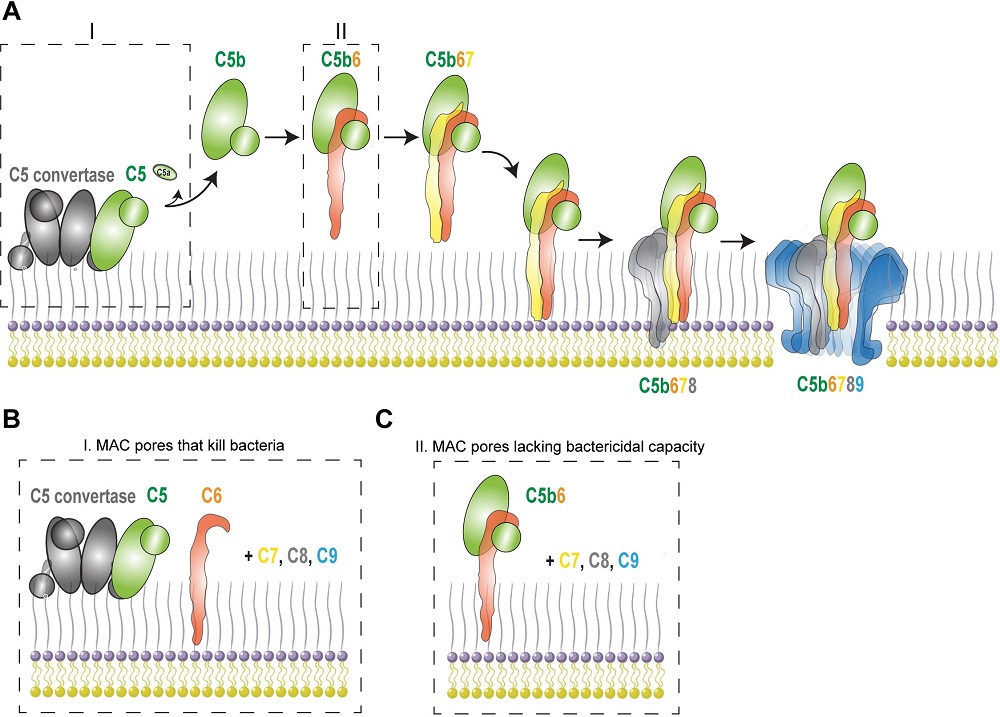Based on the accumulation of knowledge on complement therapeutic field, Creative Biolabs has established excellent platforms to support the drug discovery and validation. We are dedicated to providing a full range of biotherapeutics development services and are fully equipped to partner with our clients who are doing or may have the desire to work on complement systems for drug discovery and validation.
Membrane Attack Complex (MAC)
As part of the innate immune system, the complement system is activated by three pathways, Classical pathway, Lectin pathway, Alternative pathway. All three pathways converge into complement component C3. Physiologically, C3 is cleaved into C3a and C3b. C3b binds other components from the complement system to form the C5 convertase, cleaving C5 into C5a and C5b. C5b forms a complex called Membrane Attack Complex (MAC) or terminal complement complex (TCC) together with C6, C7, C9, and other components. MAC plays a key role in the innate and adaptive immune response by forming transmembrane channels which disrupt the cell membrane of the target cells, leading to cell lysis and cell death.

Fig.1 The illustration of the stepwise MAC assembly pathway from soluble complement factors.1, 3
Function of C6
The MAC is initiated when C5 is cleaved into C5a and C5b by the corresponding convertase. C5b is bound by C6. Structurally, C6 includes four auxiliary domains that stabilize the closed conformation, inhibiting release of membrane-inserting elements. The C5bC6 assembly binds to C7 and the resulting complex alters the configuration of the protein exposing a hydrophobic site on C7, enabling C7 to insert into the phospholipid bilayer of the target cell.
C6-Related Disease
One major end point of complement activation is the formation of the MAC. It is a circular multi-protein complex that can embed into the phospholipid membrane of a target cell forming a large pore, leading to the lysis of the target cells. C6 is an important part of MAC. The deficiency of C6 causes enhanced susceptibility to Gram-negative bacterial infections or recurrent bacterial infection such as those caused by Neisseria meningitides.
The complement system is associated with a number of “hard to treat” disorders. Working on the targets of these disorders help understand the mechanism and help the patients survive. Creative Biolabs is providing high-quality biotherapeutics development services based on the complement system. We offer turn-key or ala carte services customized to our client’s needs. Our service takes away the cost and effort of setting up assays in your laboratory and gets rapid results with minimal assay variation. If you are interested in our platform, please contact us for detailed information.
Published Data
 Fig.2 Step-wise assembly of the MAC.2, 3
Fig.2 Step-wise assembly of the MAC.2, 3
The human complement system exerts its bactericidal effect against Gram-negative bacteria by forming MAC pores. Recent studies demonstrate that local C5 conversion by surface-bound convertases is crucial for MAC-mediated bacterial killing. Researchers have elucidated that the swift interaction between C7 and C5b6 is essential for forming effective MAC pores on Escherichia coli. Experiments using fluorescently labeled C6 indicate that C7 prevents detachment of C5b6 from the bacterial surface. Additionally, analysis by trypsin shaving and atomic force microscopy underscores the necessity of this interaction for anchoring C5b-7 efficiently, enabling complete MAC assembly. Complement-resistant E. coli strains circumvent complement-mediated destruction by hindering the C5b-7 anchoring process, thus obstructing MAC pore formation despite unaffected C5 convertase assembly. These insights shed light on the molecular mechanisms underpinning MAC pore assembly and how bacterial pathogens evade this immune defense strategy.
References
-
Bayly-Jones, Charles, Doryen Bubeck, and Michelle A. Dunstone. "The mystery behind membrane insertion: a review of the complement membrane attack complex." Philosophical Transactions of the Royal Society B: Biological Sciences 372.1726 (2017): 20160221.
-
Aleshin, Alexander E., et al. "Crystal structure of C5b-6 suggests structural basis for priming assembly of the membrane attack complex." Journal of Biological Chemistry 287.23 (2012): 19642-19652.
-
Distributed under Open Access license CC BY 4.0, without modification.
Related Product
Questions & Answer
A: Drug development strategies for targeting C6 typically involve the design and testing of small molecules, monoclonal antibodies, or other biologics that can selectively inhibit or modulate C6 activity. Preclinical and clinical studies are conducted to evaluate their safety and efficacy.
A: One challenge is the fine balance between complement activation for pathogen clearance and the risk of tissue damage. Therapies targeting C6 need to be carefully designed to avoid impairing the host's ability to defend against infections while addressing complement-mediated diseases. Additionally, achieving specificity in targeting C6 without affecting other essential complement functions is a challenge.
A: In the laboratory, complement C6 is studied using various molecular and cellular techniques. Researchers may use techniques such as Western blotting and ELISA to detect and quantify C6 protein levels. Functional assays involving complement activation on target cells can assess the role of C6 in MAC formation. Additionally, advanced imaging techniques like electron microscopy can be used to visualize the MAC assembly on cell membranes, providing insights into the molecular mechanisms involving C6. Also, our functional assay kits are useful tools for C6 investigations.
For Research Use Only.
Related Sections:


 Fig.2 Step-wise assembly of the MAC.2, 3
Fig.2 Step-wise assembly of the MAC.2, 3